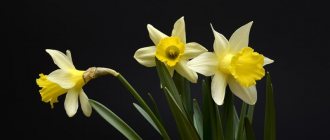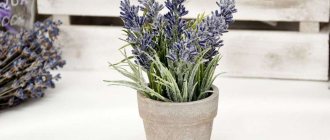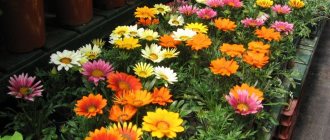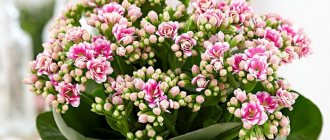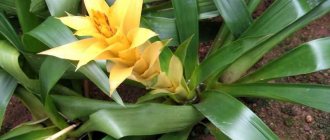Variety of domestic chrysanthemums
Chrysanthemum has a huge number of varieties, but few are suitable for growing indoors.
- Mulberry. The name indicates well the main features. It has large green leaves, carved along the edge, pubescent below.
- Chinese. A very profusely flowering shrub. It is not very tall, so it appears from a distance as a colored ball; the leaves are practically invisible behind the flower caps.
- Korean spherical. It also forms many inflorescences, like the previous variety.
There are other species that can be grown on a windowsill. Flower growers are very fond of ampelous varieties.
Choosing a place for potted chrysanthemums in the house
The first step when this flower appears at home is to choose a place for the plant that will be sufficiently well lit. Lighting with direct morning and evening rays of the sun, as well as bright diffused light, is most suitable.
The very first daylight rays of the sun can have a detrimental effect on the plant, so protect chrysanthemums from them (you can temporarily move the plant away from windows). Otherwise, under the influence of the hot rays of the sun, the buds will open and wither before they have time to fully bloom.
Description
Although the shrub is diverse, many of its species have the same characteristics.
Bush
The bushes of the plant have both a dwarf (15 cm) and a tall shape, above 150 cm. The stems are branched, mostly green. Belongs to the same family as asters.
Inflorescences and flowers
Compositae. Numerous petals amaze with the variety of colors. The entire color spectrum is represented here, ranging from white to gradually turning into purple.
Bloom
It begins in mid-August and lasts until frost.
Feeding for potted stars
For such abundant flowering, chrysanthemums need access to nutrients in very large quantities. The soil and the plant itself are greatly depleted, so these plants are fed practically like garden summer plants - very often. It is better to reduce the dose of fertilizers, but fertilize them every 1-2 weeks. After signs of the end of flowering, be sure to slowly reduce the number of feedings. Before taking it out for the winter, stop applying fertilizer. Feeding is resumed 2 weeks after transplantation.
Potted chrysanthemum. © Robert Wallace
For chrysanthemums, it is better to use special fertilizer mixtures or universal mixtures for flowering plants. If you use regular fertilizers, then add more nitrogen during the formation of the bush, and with the appearance of buds, add more potassium and phosphorus.
What to look for when buying a chrysanthemum
When choosing a chrysanthemum at a garden center, pay attention to its appearance.
You may be interested in: How to care for chrysanthemums in a pot at home
You should not take a flower if most of the leaves are yellow or have already fallen off. Examine the roots of the plant. If it has been replanted for a long time, then they will most likely stick out from the container. At the same time, you can see light, thin hairs, which means the plant is healthy. If the roots are all darkened, without small branches, then such a chrysanthemum should not be taken. The plant is already dying.
Try to remove the flower. A good root system is slightly tangled around and removed along with a lump of earth. If the lump is small, then the roots are not developed. Most likely, the chrysanthemum was only recently transplanted.
If you buy a plant in a store and do not grow it yourself, then caring for a chrysanthemum in a pot after purchase begins immediately after that.
Advantages of varieties for the home
The varieties described above were bred artificially, and therefore have a number of properties that garden flowers do not have:
- High resistance to diseases.
- No formation required.
- Flowering lasts almost 2 months.
Note!
Despite all the advantages, there is only one drawback. If you want to grow a chrysanthemum from collected seeds, most likely you will get completely different results, since these plants are hybrids.
You may be interested in:
Muraya - care at home Not only indoor plants, but also exotic ones can grow on the windowsill of a house. Muraya is a plant that can rarely be...Read more...
Care after purchase
If you do not take some measures at home, the flower may die.
- Examine the bush. If you see running insects, wash them off in a shower at room temperature, spray the bush with a solution of laundry soap, or apply insecticides.
- Remove all damaged plant parts. It is better to cut with a disinfected knife, then be sure to dispose of everything that was cut out.
- Place the chrysanthemum away from other plants for quarantine, which can last 7-14 days. If it’s warm, you can take it outside or into the garden. See what has changed every day. If young leaves appear, everything is great.
Just in case, you can treat the bush against diseases, but you cannot do this together with pest prevention; you need to wait about a week.
Pests and diseases
Diseases and their treatment
In improper conditions and with improper care, chrysanthemum can develop powdery mildew, septoria and gray rot.
Powdery mildew appears as a loose whitish coating on the leaves, petioles and shoots of the plant. As the disease progresses, the plaque becomes denser, turns brown, and the chrysanthemum loses its decorative effect. The fungi that cause the disease are destroyed by treating the plant with solutions of Fundazol, Topsin, Topaz, Skor or other fungicidal drugs.
Septoria is also a fungal disease that can be diagnosed by grey-brown or rusty spots with a yellow outline that appear on the leaves of the plant. These spots grow over the entire surface of the leaf, and in their center black dots appear - pycnidia of the fungus. Affected leaves and shoots dry out, the stems become brown, wrinkle and bend. The diseased plant should be isolated, all affected leaves and shoots should be removed, and then treated with a solution of Kuproxat, Oksikhom or copper sulfate. The chrysanthemum should remain in quarantine until you are sure it is healthy.
Gray mold, or botrytis, is also fungal in nature, but getting rid of this disease is more difficult than powdery mildew or septoria. The disease covers the ground organs with a gray fluffy coating, under which the plant tissues die. Botrytis is destroyed with Bordeaux mixture, and it is better to treat the plant with this drug before flowering begins.
Pests and their control
Among the pests that pose a danger to chrysanthemums are aphids, chrysanthemum nematodes, thrips and slobbering pennies.
Aphids, thrips and pennies are sucking pests that feed on plant cell sap. They are destroyed by treating the chrysanthemum with insectoacaricidal preparations such as Actellik, Derris, Confidor, Biotlin or Aktara.
As for the nematode, it is a tiny thread-like worm and its presence on chrysanthemum cannot be detected. The damage to the plant by nematodes may be indicated by the appearance of white mosaic spots between the veins of the lower leaves, which gradually turn brown. Subsequently, the leaves curl, dry out and fall off, and mosaic spots begin to appear on the upper leaves.
Infection of domestic chrysanthemums with nematodes can occur through soil that has not been disinfected. Unfortunately, you will not be able to save the plant from death, so it must be destroyed along with the soil in which it grew.
- Schefflera - care, photos, types
Transfer
After quarantine, the next stage of caring for a chrysanthemum in a pot at home after purchase is replanting. If the plant blooms, you must wait until the process is completed. If not, you can replant in a week.
The container is selected to be 2-3 cm larger than the previous one. It is washed and disinfected by dipping it into a solution of potassium permanganate or another liquid, for example, diluted ammonia.
You can buy soil suitable for chrysanthemums in a store or make it yourself by adding sand and humus to the garden soil.
What happens if a purchased chrysanthemum bush is planted entirely in the garden?
If you do this in September, it will bloom beautifully until the onset of persistent frosts. You can then dig it up and transplant it into a pot to make a queen cell out of it or leave it to overwinter outside. Given the kind of winters we have had, most likely with little shelter and perhaps even without it, the bush will overwinter and begin to grow in the spring. BUT, as mentioned above, such beautiful, neat flowering most likely will not happen. Chrysanthemum requires constant rejuvenation.
Before wintering, cut the bush to a height of no more than 10 cm and sprinkle with peat. You can put lutrasil on top.
Temperature
Chrysanthemum is a lover of high-temperature climates.
In summer, it can begin to bloom when the scale is 20-23 degrees.
Fact!
If frost sets in, you can bring the chrysanthemum into the house, but it will withstand a short drop to -2 °C.
In winter, be sure to give the plant a rest period; an insulated glazed balcony will help with this, where the temperature will be from 3 to 8 degrees.
When to send a chrysanthemum to sleep
The remaining flowers have faded, the bush becomes dull, the leaves become a little lethargic. When there are no buds left on the plant, it’s time to “put” the chrysanthemum to sleep.
In the modern world, the calendar dates have changed, which let you know when chrysanthemums bloom. In October you can buy blooming chrysanthemums with large flowers, but they are late bloomers. The upper buds of such chrysanthemums will open in November, and flowering will end in December-January. However, when such a chrysanthemum is “helped” to bloom early, the dormant stage may well begin in November.
Korean chrysanthemums bloom for quite a long time in open soil, in accordance with the period that corresponds to this variety. Chrysanthemums “Malchish-Kibalchish” bloom very early. Their flowers begin to open in July. August marks the peak of flowering of chrysanthemums such as “First Snow”. Chrysanthemums “Altgold” and “Snow White” bloom later than everyone else (until the frost).
If plants are grown at home, the timing of when they bloom will shift. If you organize the correct conditions for keeping potted chrysanthemums in the house, they can bloom for up to 2 months. November-December is a time of rest.
Watering and spraying
Caring for a potted plant at home after purchase is not very difficult if you follow all the recommendations. Chrysanthemums love water very much, but not too much.
Good owners monitor the humidity and add liquid only when the top part of the soil dries out.
How to stimulate chrysanthemum flowering
It is important to follow several rules so that the plant blooms faster:
- Water abundantly, not allowing the soil to dry out.
- Make 12 hours of daylight.
- During the formation of buds, the plant should stand in a cool place + 13 ... + 16 ° C.
- While the buds are small, remove the small ones, leaving only the large ones.
- When all the buds open, provide good lighting.
- Transplant into a spacious container.
- Fertilize with nitrogen before flowering.
Winter care
In winter, chrysanthemums must be provided with rest. The temperature decreases as described above. The bush is pruned, all old branches and weak stems are removed, then shortened by a third.
Two weeks before the start of wintering, fertilizer is applied for the last time, watered well, since at least 21 days will pass before the next watering. The plant is exposed to a cold place. The chrysanthemum will remain hibernating until the first month of spring.
About the soil mixture and transplantation conditions
Despite the fact that chrysanthemum is considered a garden plant, its potted counterpart requires special soil. It is possible to purchase a store-bought soil mixture, or you can prepare it yourself.
Important : the bright beauty prefers loose soil, but you should fluff it up by hand carefully so as not to damage the rhizome.
Before transplanting a homemade chrysanthemum from a pot into a new container, you should mix the following substrate ingredients:
- turf soil;
- leaf soil;
- humus;
- coarse sand.
It doesn’t matter whether replanting is in spring or autumn, the main thing is that the soil is slightly acidic.
Before use, the soil is heated in the oven for the purpose of disinfection. If the mixture is purchased, this is not necessary.
Chicken manure in small quantities has a positive effect on flower growth. It can be added to the soil from the very beginning. The concentration should be calculated carefully, as the acidity of the soil increases.
The new container should be slightly larger than the old one - a couple of centimeters in diameter. Ceramic products are ideal, but plastic can also be used. In any case, there should be drainage holes in the bottom.
Before planting, disinfected pebbles or expanded clay are first laid out.
Important : during the procedure, the old earthen ball is completely destroyed, and planting is carried out in absolutely fresh soil mixture. Only in this case will the plant bloom again.
How to fertilize
Fertilizing is not much different from fertilizing other plants.
At the beginning of the growing season, that is, in March, organic mixtures that are rich in nitrogen are introduced.
Important!
It is necessary to replace fertilizers on time, since nitrogen does not promote flowering.
This contributes to the growth of green mass, then they switch to phosphorus and potassium.
Features of plant flowering
Chrysanthemum Zembla - care and propagation
All chrysanthemums are plants of shortening daylight hours. For this reason, they bloom only from the second half of summer, in autumn, when the day is rapidly waning.
Period of activity and rest
Typically, the flowering period from the formation of buds to the wilting of the last flower lasts 6-10 weeks. The timing directly depends on the variety. In winter, there is a period of complete dormancy, the above-ground part is almost completely removed, and the pots are kept in a dark and cool place. Spring and the first half of summer are the time for the formation of a new lush bush.
Types and shape of flowers
A chrysanthemum flower is a basket in which the outer rows consist of flowers with long petals, and the central part consists of small and short tubular flowers. The number and shape of long flowers determines what the corolla will be - simple, semi-double or double.
Indoor large-flowered double yellow and white chrysanthemums
Why might it not bloom?
There are several reasons for the lack of flowering, but they are all well known and easily eliminated:
- Lack of lighting. The required daylight hours for chrysanthemums in the house is 9 hours. If the light comes in only 7 hours a day, then this can cause the buds to weaken, they simply will not open and begin to dry out.
- Lack of nutrition. In summer and autumn, fertilizers with a predominance of phosphorus and potassium are applied once every 2 weeks. If there are no buds, you should feed the plants.
- Too much and late pruning. Having removed shoots with buds, you will have to wait a long time for new ones to form.
Chrysanthemum propagation
Reproduction is carried out in two ways: dividing the bush and cuttings. For cuttings, take twigs cut from a chrysanthemum bush.
These may be those left over from pruning. They are placed in a glass of water to which a root former has been added or planted in the soil at an angle, keeping it well moistened. In both cases, the cuttings are covered with agrotextile or polyethylene.
Periodically, the seedlings are inspected to ensure that rot does not appear and they are ventilated. The flowers themselves will tell you whether the chrysanthemum has taken root. Young leaves will begin to appear, after which the shelter is removed. The second method is most often carried out during transplantation, when the overgrown roots are separated from each other. A pruning shear or a sharp, but always alcohol-wiped, knife can help with this.
The cut site is sprinkled with ash or dipped in Kornevin and Zircon and planted in the same way as described above.
After purchasing, caring for chrysanthemums in a pot at home is not burdensome. It does not require special attention like other plants, but will appreciate proper handling.
Indoor chrysanthemum - what kind of flower is it, a brief description
In indoor culture, an ordinary perennial chrysanthemum is grown, but its varietal characteristics are selected to make it compact and bloom luxuriantly for 10 weeks or longer.
Potted chrysanthemum
The following varieties are available for sale:
- Globular. The bush consists of shoots of different lengths tightly gathered into a rosette, forming a crown in the shape of a regular ball.
- Bush. It has a trunk and numerous branching shoots.
- Ampelnaya. One of the rarest, it stands out for its creeping or drooping, highly branched shoots.
- Classic. Its crown is formed by several strong, erect shoots, ending in single inflorescences or collected in a loose cluster.
Flowers are double, semi-double and single. The corolla is a basket in which the outer rows are formed by flowers with long petals, and the core is formed by short tubular ones, usually yellow. The coloring is very different - monochromatic and two-color.
Ampel chrysanthemum
The leaves of chrysanthemums vary greatly in size and are green or dark green in color. The surface of the leaf blades is velvety and, when touched, emits a pleasant bitter-herbaceous aroma. Flowers usually smell much stronger, but almost odorless hybrids have been bred for indoor conditions.
The root system is a highly branched rhizome. In adult plants, it can be cut into several parts, each of which will serve as excellent planting material. The main propagation is by seed.
Pruning and shaping bushes
For potted chrysanthemums, not one, but several trimmings are needed:
- removal of fading inflorescences, which need to be removed from the bushes as quickly as possible;
- pinching the tops to form a dense and compact crown, which is carried out 2-3 times in spring and early summer;
- if you want to limit the height of the bushes or stimulate a second wave of flowering in winter, restraining pruning of 1/3 of the shoots;
- pruning before wintering, which is carried out to small stumps, removing all above-ground parts.
Substrate for potted chrysanthemums : any soil mixture with a loose texture, an admixture of sand and transfer (except for acidic ones).
Transplantation time : perennial chrysanthemums are replanted annually, old bushes - once every two years, immediately after signs of growth appear in the spring. Drainage is laid at the bottom of the containers, the depth level is kept the same.

